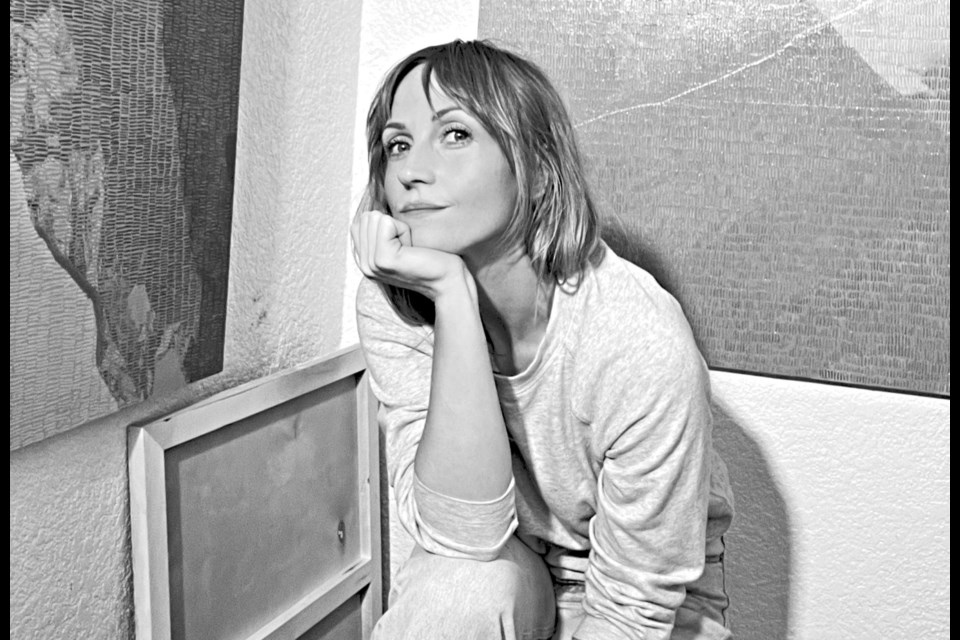In another life, April Matheson might have been a pharmacist.
She came close, but a dreadful feeling settled in her gut two weeks before university. The Ontarian realized her imminent career choice would one day land her in a white-walled building illuminated by fluorescent light, telling elderly people that the prescription they sought wasn’t covered by their insurance. She’d always been a science kid, but she didn't want that life.
Matheson pivoted on short notice toward a Bachelor of Fine Arts at the University of Manitoba—a school that had previously attracted her with its pharmacy program. She grinded through a brutal academic schedule as a result of her last-minute major change, and pursued no projects beyond what her degree required for her.
Today, Matheson is pushing 40 and headed to the Whistler Contemporary Gallery (WCG) from Jan. 7 to 11 as an Artist in Residence. It will be her second Sea to Sky trip this year after an April residency at the Fairmont. The path she took to reach this point is unconventional, as is her style of content creation.
Getting it right
Growing up in Fort Frances, a Northwest Ontario town of just under 7,500 on the American border, Matheson’s artistic aptitude co-existed with her science chops from a young age. She’s been drawing since before she could talk, but never seriously pursued art as a kid. Even after completing her undergraduate degree, she initially found work at an independent boutique.
“People in cold climates are creative because they have to be,” Matheson says. “I was given a lot of creative responsibility for store design and marketing, and it was a lot of fun curating collections of clothing for people to wear. I think I liked it because there's a psychology element to it and a math element to it.”
There’s nothing wrong with any of that. Plenty of art school grads build careers outside of straight-up drawing and painting—but Matheson eventually realized something else about herself. Her creativity had, for many years, been hamstrung by her own perfectionism and a weighty fear of being criticized.
“About five years ago, it occurred to me that I wasn't creating because I was afraid of ‘not getting it right,’” Matheson admits. “So I started experimenting with different mediums and techniques, initially just scribbling on paper and eventually progressing to more complex works. The goal was just to play and make a mess, and through that I developed a process I absolutely love that defies the traditional usage of oil paint.
“Essentially I’m making a painting, covering it in oil paint, then repeatedly removing bits of the oil paint to reveal little windows to the image underneath. It's unconventional, breaks the rules, and it's uniquely mine.”
Matheson hesitates to liken her style to any particular genre. Instead, she prefers for viewers to behold her work and decide how to interpret it. People have certainly begun to take notice.
A watershed moment in Matheson’s career came in November of 2020: her first solo art show. COVID-related restrictions wiped out the typical opening reception and tempered her expectation with regard to public response. Yet an interior designer walked in during the very first hour of that rainy Tuesday, pointed to the largest piece in Matheson’s collection and declared that she needed it. The woman was trying to build her dream home and felt that Matheson’s work fit perfectly.
It was an unexpected but welcome reminder to Matheson that if she continues to make what she loves, people will respond with love.
Remove and reveal
Newfound creative courage has liberated Matheson from the trepidation-inducing tendencies of her perfectionist side. Her method, referred to as ‘remove and reveal’ by others, is a break from the technical constraints of the realism she grew up with. Now, Matheson experiments with all sorts of mediums, including acrylic, oil and collage, in an unfettered way.
She happily accepted WCG’s invitation to collaborate and remembers a sense of communal positivity from her last visit to Whistler, near the end of ski season. Matheson isn’t burdening herself with any expectations going into this residency. Instead, she hopes simply to meet people and have a good time.
“I really enjoy connecting with people, which I don't get to do when I'm in my studio with a lot of podcasts and whatever album I’m fixated on at the moment,” she says. “Nothing was calculated about [my Fairmont residency]. My process is really almost meditative for people to watch. For me, it feels like a marathon: once I lay down some paint, I have a few hours of time to etch it all off.”
More than anything else, Matheson hopes to encourage others to express their creative selves without fear.
“There's a gatekeeping aspect to art, but I think we all participated in some way,” she opines. “We all grew up coloring and drawing and painting, at some point we’re like: ‘oh, I'm not good at that,’ and I just think that's really kind of sad. The big thread that I noticed talking with people [during my first residency] is that they were all a little shy about their creative hobbies.
“It was nice to also talk to little kids…and tell them: ‘keep painting, you don’t have to follow the rules’, giving them advice that I wish I would have got when I was younger. I was so afraid of art for such a long time—I was so afraid of making a mistake or people not liking it—and then I had to train myself out of it over a multi-year period.”




